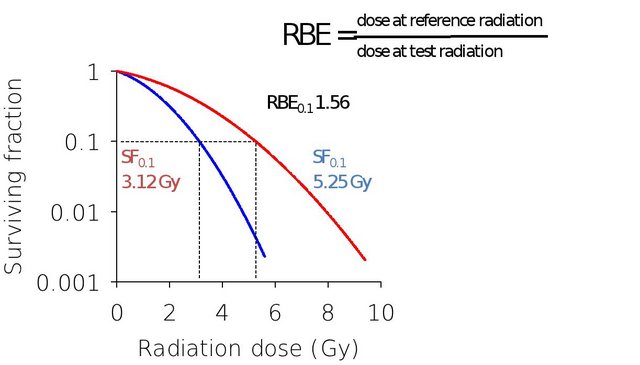Radiation damage to tissue is mainly caused by ionization effects in the DNA in the cells. Because radiation with high linear energy transger (LET) produces dense energy deposits, the correlated damages of the DNA structure within one cell occur more often than for conventional x-ray radiation. And consequently, it becomes more difficult for the cancerous cell to repair the damage, leading to a markedly increased efficiency of cell killing [1]. The concept of relative biological effectiveness (RBE) has been introduced to account for this increased efficiency. RBE is defined as the ratio of a dose of photons to a dose of any other particle radiation to produce the same biological effect. High LET has an increased biological efficiency of the dose by a factor between 1.5 and 3 compared to low LET radiation [2]. Generally speaking, photon and proton beams have a similar RBE which is substantially lower than the RBE of carbon beams. This is complicated by the fact that RBE is not a constant, but depends, among others, on the specific tissue, on the particle energy, on cell cycle distribution, and on the tumour microenvironment.

When studying the effectiveness of carbon ion therapy, the effect on the normal tissue is of special interest. A significant increase of the RBE at high LET would also enhance the unwanted side-effects, which questions whether a gain can be achieved. The difference in the response of normal and tumour cell is minimum at an intermediate LET of 100-150 keV/µm [3,4] counteracting the therapeutic goal. Effects of radiation exposure on normal tissue consist of both early and late effects. Amongst early, acute effects, skin reactions, which mostly are reversible, are often seen. Fibrosis, on the other hand, is a common late damage effect of irradiation, which is irreversible and a dose-limiting factor for healthy tissue in radiotherapy.
Biological questions involved in particle therapy include 1) whether there is a biological gain of the particle therapy (normal tissue damage versus therapeutic gain); 2) whether the biological effectiveness seen in vitro can be found in in vivo studies and 3) whether heavy ions, due to high-LET, are superior to protons. The answer to these questions can be found by comparing the differential RBE between tumour and normal tissue for both protons and carbon ions.
We are collaborating with GSI, and the work is supported by ULICE - Union of Light Ion Centres in Europe, the Danish Cancer Society, and CIRRO - The Lundbeck Foundation Centre for Interventional Research in Radiation Oncology.
[1] Goodhead DT. Mechanisms for the biological effectiveness of high-LET radiations. J Radiat Res (Tokyo) 1999;40 Suppl:1-13.:1-13.
[2] Jäkel O. The relative biological effectiveness of proton and ion beams. Z Med Phys 2008;18(4):276-85.
[3] Katz R, Cucinotta FA. Tracks to therapy. Radiat Meas 1999;31(1-6):379-88.
[4] Hall EJ, Giaccia A. Radiobiology for the radiologist. Sixth Edition edn. Philadelphia: Lippincott Williams & Wilkins; 2006.
Back to APTG main page